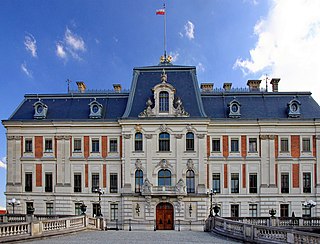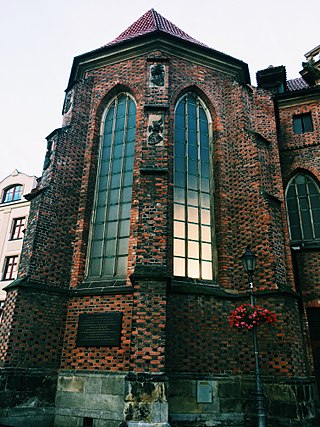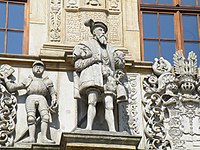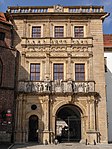
Legnica is a city in southwestern Poland, in the central part of Lower Silesia, on the Kaczawa River and the Czarna Woda. As well as being the seat of the county, since 1992 the city has been the seat of the Diocese of Legnica. As of 2023, Legnica had a population of 97,300 inhabitants.

Opole Voivodeship, is the smallest and least populated voivodeship (province) of Poland. The province's name derives from that of the region's capital and largest city, Opole. It is part of Upper Silesia. A relatively large German minority lives in the voivodeship, and the German language is co-official in 28 communes.

Silesia is a historical region of Central Europe that lies mostly within Poland, with small parts in the Czech Republic and Germany. Its area is approximately 40,000 km2 (15,400 sq mi), and the population is estimated at 8,000,000. Silesia is split into two main subregions, Lower Silesia in the west and Upper Silesia in the east. Silesia has a diverse culture, including architecture, costumes, cuisine, traditions, and the Silesian language. The largest city of the region is Wrocław.

Opole is a city located in southern Poland on the Oder River and the historical capital of Upper Silesia. With a population of approximately 127,387 as of the 2021 census, it is the capital of Opole Voivodeship (province) and the seat of Opole County. Its built-up was home to 146,522 inhabitants. It is the largest city in its province.

Upper Silesia is the southeastern part of the historical and geographical region of Silesia, located today mostly in Poland, with small parts in the Czech Republic. The area is predominantly known for its heavy industry.

Lower Silesian Voivodeship in southwestern Poland, is one of the 16 voivodeships (provinces) into which Poland is divided. The voivodeship was created on 1 January 1999 out of the former Wrocław, Legnica, Wałbrzych and Jelenia Góra Voivodeships, following the Polish local government reforms adopted in 1998. It covers an area of 19,946 square kilometres (7,701 sq mi), and as of 2019 has a total population of 2,899,986.
The Duke of Silesia was the sons and descendants of the Polish Duke Bolesław III Wrymouth. In accordance with the last will and testament of Bolesław, upon his death his lands were divided into four or five hereditary provinces distributed among his sons, and a royal province of Kraków reserved for the eldest, who was to be High Duke of all Poland. This was known as the fragmentation of Poland. Subsequent developments lead to further splintering of the duchies.

Brzeg is a town in southwestern Poland with 34,778 inhabitants and the capital of Brzeg County. It is situated in Silesia in the Opole Voivodeship on the left bank of the Oder river.

Kluczbork is a town in southern Poland with 23,554 inhabitants (2019), situated in the Opole Voivodeship. It is the capital of Kluczbork County and an important railroad junction.

Oława is a historic town in south-western Poland with 33,029 inhabitants (2019). It is situated in Lower Silesian Voivodeship, within the Wrocław metropolitan area. It is the seat of Oława County and of the smaller administrative district of Gmina Oława.

The Duchy of Silesia with its capital at Wrocław was a medieval duchy located in the historic Silesian region of Poland. Soon after it was formed under the Piast dynasty in 1138, it fragmented into various Silesian duchies. In 1327, the remaining Duchy of Wrocław as well as most other duchies ruled by the Silesian Piasts passed to the Kingdom of Bohemia as Duchies of Silesia. The acquisition was completed when King Casimir III the Great of Poland renounced his rights to Silesia in the 1335 Treaty of Trentschin.

Grodków is a town in Brzeg County, Opole Voivodeship in Poland, the administrative seat of Gmina Grodków. It is located in the Silesian Lowlands of the Oder basin, in the historic Upper Silesia region, about 20 km (12 mi) south of Brzeg. In the north, it has access to the A4 autostrada. The town has 8,595 inhabitants (2019).

Lower Silesia is a historical and geographical region mostly located in Poland with small portions in the Czech Republic and Germany. It is the western part of the region of Silesia.

Niemcza is a town in Dzierżoniów County, Lower Silesian Voivodeship, in south-western Poland. It is the seat of the administrative district (gmina) called Gmina Niemcza.

Pszczyna Castle is a classical-style palace in the town of Pszczyna in southern Poland. Constructed as a castle in 13th century or earlier, in a Gothic architectural style, it was rebuilt in a Renaissance style in the 17th century. During the course of the 18th and 19th centuries, the exterior of the castle was partially changed into a Baroque-Classical style. The Classicist modernization transformed the complex into what is usually described a palace.

The Silesian Piasts were the elder of four lines of the Polish Piast dynasty beginning with Władysław II the Exile (1105–1159), eldest son of Duke Bolesław III of Poland. By Bolesław's testament, Władysław was granted Silesia as his hereditary province and also the Lesser Polish Seniorate Province at Kraków according to the principle of agnatic seniority.

The Duchy of Brzeg or Duchy of Brieg was one of the Duchies of Silesia, created in 1311 during the fragmentation of the Duchy of Wrocław. A Bohemian fief from 1329, it was ruled by the Silesian Piasts until their extinction in 1675. Its capital was Brzeg in Lower Silesia.

Bolków Castle is a castle located in Bolków on the Castle Hill, with a 396 metres, where the hillside is cut by the Nysa Szalona river, with a sharp precipice ; the eastern side of the hill gradually lowers, taken up by the town. The castle is an upland stronghold, covering an area of 7600 m2. The castle is located in Bolków, Lower Silesian Voivodeship; in Poland.

St. Jadwiga's Church in Brzeg, Poland, is a Gothic castle church built in the fourteenth century.

The coat of arms of Lower Silesia, and simultaneously of Silesia, shows a black eagle with silver crescent with cross in the middle on its chest on a golden background. It has been assumed in the tradition that the coat of arms and colors of Lower Silesia are simultaneously used as symbols of Silesia as a whole.
























